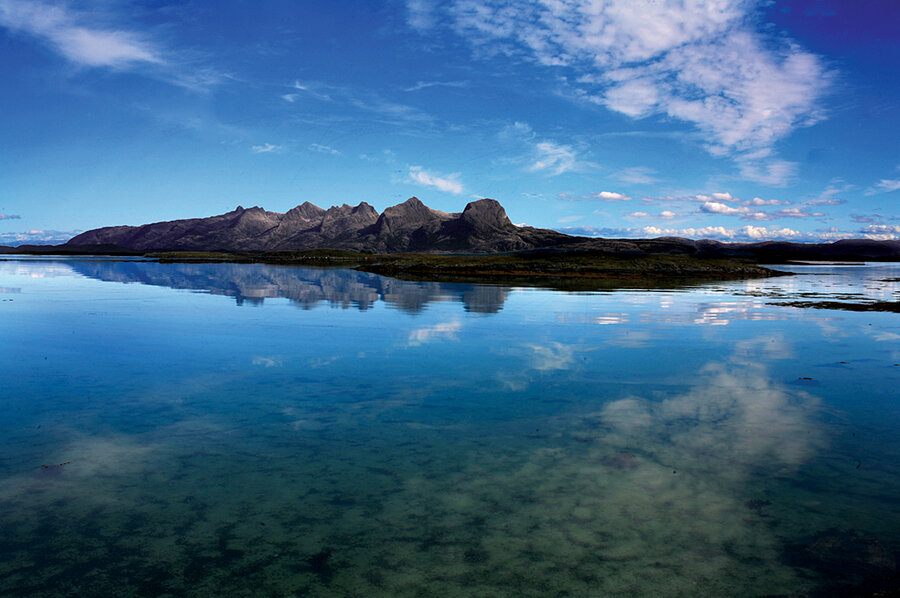A deep northern quiet in Norway
Loading...
Two trains and 600 miles north of Oslo, at a latitude higher than Iceland, Hudson Bay, and Anchorage, Alaska, lies the municipality of Leirfjord, an expanse of natural delight along Norway's Helgeland coast with a population density of 11 per square mile.
Leaving from Berlin, it was the longest I'd ever traveled to get somewhere. It was also the farthest north I'd ever been, and still there was as much lanky landmass ahead of us as there was behind.
We were north enough, however. Midnight sun was over, but even in summer's waning days a murky blue reigned over the big sky till morning. The lingering twilight allowed plenty of time to explore the dramatic landscape, exaggerated by the warm hues and long shadows. Norway's treasures – the fiords, descendants of millions of years and more than a few ice ages – filled every view.
I didn't know much about fiords, thinking mostly of Douglas Adams's reference to them in "The Hitchhiker's Guide to the Galaxy" whenever I heard the word. What I've learned since is how deceptive they can be. Leirfjord (it's in the name, and rightly so) is on the coast of the Norwegian Sea, an extension of the north Atlantic, but being there you wouldn't know it. There is no coastline, but rather a rough space between land and water slashed by dozens of islands, mountain ranges, and cliff faces, within which the open ocean has laid claim. You are reminded of landlocked lakes of Italy and Switzerland, but this is an illusion. You aren't landlocked at all.
Just how exposed Leirfjord is to the open ocean becomes more apparent at a higher elevation. The mountains that shape the fiords go up to 3,000 feet, and we reached the top of one of the smaller ones in time for sunset. Black strips of land and rocky outcrops emerged from an otherwise indifferent swath of sea, which ran off with the sky over the horizon.
Few topographies rival the complexity of the Helgeland coast. In one direction, you see rolling green hills for farmers and ranchers; in the other direction, direct access to the sea. A fisherman's paradise, and thanks in part to the geographical obstructions that shape the fiords, the water achieves a level of clarity and consistency unknown to other coastal zones.
We spent our long days hiking, fishing, island hopping, and doing our best to keep away from grazing moose hyperprotective of their young. Mostly, we absorbed the still hush of a remote and largely unblemished corner of Western Europe. What sounds there were, most often the tinkling of cowbells, carried for miles. It was a commanding quiet. Far from the noises of modern life, we in turn became quieter. To be loud felt out of step with the surroundings.
The sun setting, the Earth revolving, the tides ebbing... Nature was in constant flux and there was not much more than the whip of the wind to evidence such perfect chaos. I felt so small, and a simple thought came to mind: For a pale-blue dot, our world is a pretty big place. There are lands much larger and more desolate than Norway, and an ocean bigger than the Atlantic, and still I was confronted with an unfolding panorama beyond the scope of my ability to contemplate.
It's true that on the cosmic scale our home is but a speck of light lost among billions of other specks. It can be a dispiriting notion, but should not cause us to overlook how much this speck can pack in. If anything, it should inspire unending awe. We are Earth's dominant and most developed species, but our advancement pales against all that was already here waiting for our evolution.
Few interact directly with the natural world on a regular basis, which makes it easy to forget and harder to contemplate the vastness we are as much a part of as we have become a threat to. Our cities, institutions, and experts create a facade of control, but faraway places like Leirfjord remind us how much is not up to us. Nature is ultimately in charge and we are merely its guests. We should be humbled.





